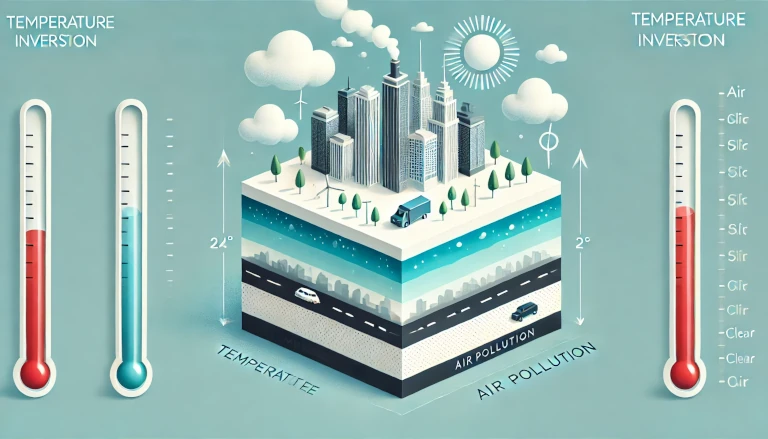A temperature inversion occurs when a layer of warm air traps cooler air close to the Earth’s surface, disrupting the natural tendency of air to rise as it heats. This phenomenon prevents the upward movement of air, causing pollutants such as smoke, dust, and smog to become trapped in the lower atmosphere. Temperature inversions can lead to significant environmental and health problems, especially in urban areas where air pollution is already high.
What is Temperature Inversion? 🌫️
Temperature inversion, also known as a thermal inversion, is an atmospheric condition in which the temperature increases with height rather than decreasing. Normally, air near the Earth’s surface is warmer, and as it rises, it cools. During a temperature inversion, this natural convection process is disrupted, and the cooler air remains trapped near the surface while a layer of warm air rests above it.
Why Does Temperature Inversion Happen? 🤔
Temperature inversions occur for several reasons:
- Radiational Cooling: On clear, calm nights, the ground loses heat quickly, causing the air near the surface to cool faster than the air above.
- Valley Effect: In valleys, cold air can get trapped in low-lying areas while warm air settles above.
- Frontal Inversions: When a cold front meets a warm front, the cold air gets trapped under the warm air, leading to an inversion.
- Subsidence Inversions: High-pressure systems can cause air to sink, compressing and warming the air at higher altitudes while trapping cooler air below.
Where Does Temperature Inversion Occur? 🌏
Temperature inversions are common in urban areas, valleys, and mountain regions, especially in the winter months. Some notable places prone to temperature inversions include:
- Los Angeles, USA: The combination of geographic layout and high pollution levels often leads to smog problems exacerbated by temperature inversions.
- Delhi, India: During the winter, Delhi experiences severe temperature inversions, which worsen air pollution, leading to public health concerns.
- Mexico City, Mexico: Surrounded by mountains, this city often suffers from inversion layers that trap pollutants.
When is Temperature Inversion Most Likely to Occur? 📅
Temperature inversions are most likely to occur during:
- Winter months: Cool ground temperatures and stable atmospheric conditions are conducive to inversions.
- Night and early morning: Inversions typically form during the night when the ground cools quickly and dissipate during the day when the sun heats the Earth’s surface.
How Much Does Temperature Inversion Impact Air Quality? 🌫️
Temperature inversions can have a dramatic impact on air quality, especially in areas with high levels of industrial activity, traffic, or natural pollution sources (e.g., wildfires). By trapping pollutants near the ground, inversions lead to:
- Smog formation: The build-up of ozone and particulate matter (PM) leads to thick layers of smog.
- Increased respiratory issues: People, especially those with asthma or other lung conditions, are more likely to experience health issues during inversions.
- Visibility issues: High pollution levels during temperature inversions can reduce visibility, posing risks for transportation.
Advantages and Disadvantages of Temperature Inversions ⚖️
Advantages:
- Stability in Weather Conditions: Inversions can lead to clear skies and calm weather conditions, which is why you often see clear mornings after a night with an inversion.
- Predictability: Inversions are relatively easy to predict, allowing cities to issue warnings about air quality concerns.
Disadvantages:
- Poor Air Quality: The most significant drawback of a temperature inversion is the buildup of pollutants, which can lead to severe health issues.
- Increased Smog and Respiratory Problems: Pollutants such as carbon monoxide and nitrogen dioxide are more likely to be trapped during inversions, increasing health risks.
Cost Benefits of Addressing Temperature Inversion Effects 💰
Investing in technologies and regulations to reduce the impact of temperature inversions has multiple cost benefits:
- Lower Healthcare Costs: Reducing air pollution caused by inversions can lead to fewer hospital visits and lower healthcare costs for pollution-related illnesses.
- Improved Public Health: By improving air quality, cities can increase overall life expectancy and reduce the burden of respiratory diseases.
- Increased Economic Productivity: Healthier populations lead to greater productivity and fewer workdays lost due to pollution-related health issues.
Solutions to Mitigate the Effects of Temperature Inversions 🌱
Addressing the effects of temperature inversions requires both individual and governmental efforts. Here are a few solutions:
- Reducing Emissions: Governments and industries should work towards reducing the emissions of pollutants, particularly PM2.5, NO2, and CO2.
- Cleaner Transportation: Encouraging the use of public transport, electric vehicles, and biking can reduce vehicular emissions that contribute to pollution during inversions.
- Air Quality Monitoring: Using real-time air quality monitoring systems can help cities predict when inversions are likely to happen, allowing residents to take precautionary measures.
- Tree Planting: Trees and green spaces can help absorb pollutants and improve air quality, particularly in urban areas.
Addressing Temperature Inversion for Better Air Quality 🌍
Temperature inversions are natural occurrences, but their effects on air quality, especially in densely populated or industrialized areas, can be harmful. Understanding the causes, risks, and mitigation strategies for temperature inversions can help cities and individuals take proactive measures to reduce pollution and protect public health. By reducing emissions and adopting green solutions, we can mitigate the harmful impacts of temperature inversions and improve the overall quality of the air we breathe.
By understanding temperature inversions and how they impact air quality, we can take action to reduce pollution and improve public health.
Discover more from Green Ecosystem - Renewable Energy, Agriculture, and Environmental Sustainability
Subscribe to get the latest posts sent to your email.


